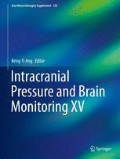Abstract
Intracranial pressure (ICP) is a major neurological parameter in animals and humans. ICP is a function of the relationship between the contents of the cranium (brain parenchyma, cerebrospinal fluid, and blood) and the volume of the skull. Increased ICP can cause serious physiological effects or even death in patients who do not quickly receive proper care, which includes ICP monitoring. Epilepsies are a set of central nervous system disorders resulting from abnormal and excessive neuronal discharges, usually associated with hypersynchronism and/or hyperexcitability. Temporal lobe epilepsy (TLE) is one of the most common forms of epilepsy and is also refractory to medication. ICP characteristics of subjects with epilepsy have not been elucidated because there are few studies associating these two important neurological factors. In this work, an invasive (ICPi) and the new minimally invasive (ICPmi) methods were used to evaluate ICP features in rats with chronic epilepsy, induced by the experimental model of pilocarpine, capable of generating the main features of human TLE in these animals.
Access this chapter
Tax calculation will be finalised at checkout
Purchases are for personal use only
References
Arida RM, Scorza FA, Santos NF, Peres CA, Cavalheiro EA (1999) Effect of physical exercise on seizure occurrence in a model of temporal lobe epilepsy in rats. Epilepsy Res 37:45–52
Babb TL (1999) Synaptic reorganizations in human and rat hippocampal epilepsy. Adv Neurol 79:763–779
Bartolomei F, Khalil M, Wendling F, Sontheimer A, Regis J, Ranjeva JP et al (2005) Entorhinal cortex involvement in human mesial temporal lobe epilepsy: an electrophysiologic and volumetric study. Epilepsia 46:677–687
Cavalheiro EA (1995) The pilocarpine model of epilepsy. Ital J Neurol Sci 16:33–37
Covolan L, Mello LE (2006) Assessment of the progressive nature of cell damage in the pilocarpine model of epilepsy. Braz J Med Biol Res 39:915–924
Czosnyka M, Pickard JD (2004) Monitoring and interpretation of intracranial pressure. J Neurol Neurosurg Psychiatry 75(6):813–821
Dalby NO, Mody I (2001) The process of epileptogenesis: a pathophysiological approach. Curr Opin Neurol 14:187–192
Dichter MA (1994) Emerging insights into mechanisms of epilepsy: implications for new antiepileptic drug development. Epilepsia 35(Suppl 4):S51–S57
Duncan JS, Sander JW, Sisodiya SM, Walker MC (2006) Adult epilepsy. Lancet 367:1087–1100
Duran RV, Bastos EM, Arashiro DK, Gorgulho A, Purcelli MCSC, Rivero RL, Kohmann CM, Mello LEAM (1993) Status epilepticus and spontaneous seizures in the pilocarpine and kainic acid models of epilepsy. Soc Neurosci Abstr 19:394
Goitein KJ, Shohami E (1983) Intracranial pressure during prolonged experimental convulsions in cats. J Neurol 230(4):259–266
Hauser WA, Annegers JF, Rocca WA (1996) Descriptive epidemiology of epilepsy: contributions of population-based studies from Rochester, Minnesota. Mayo Clin Proc 71:576–586
Mascarenhas S, Vilela GHF, Carlotti C, Damiano LEG, Seluque W, Colli BO, Tanaka K, Wang CC, Nonaka KO (2012) New ICP minimally invasive method shows Monro-Kellie doctrine not valid. Acta Neurochir Suppl 114:117–120
Mathern GW, Adelson PD, Cahan LD, Leite JP (2002) Hippocampal neuron damage in human epilepsy: Meyer’s hypothesis revisited. Prog Brain Res 135:237–251
Mathern GW, Kuhlman PA, Mendoza D, Pretorius JK (1997) Human fascia dentata anatomy and hippocampal neuron densities differ depending on the epileptic syndrome and age at first seizure. J Neuropathol Exp Neurol 56:199–212
Shah AK, Fuerst D, Sood S, Asano E, Ahn-Ewing J, Pawlak C (2007) Seizures lead to elevation of intracranial pressure in children undergoing invasive EEG monitoring. Epilepsia 48(6):1097–1103
Solheim AO, Vik SG, Eide PK (2008) Rapid and severe rise in static and pulsatile intracranial pressures during a generalized epileptic seizure. Seizure 17:740–743
Turski WA, Cavalheiro EA, Schwarz M, Czuczwar SLJ, Kleinrok Z, Turski L (1983) Limbic seizures produced by pilocarpine I rats: behavioral, electroencephalographic and neuropathological study. Behav Brain Res 9:315–335
Turski WA, Czuczwar SJ, Kleinrok Z, Turski L (1983) Cholinomimetics produce seizures and brain damage in rats. Experientia 39:1408–1411
Wieser HG (2004) ILAE Commission on Neurosurgery of Epilepsy. ILAE Commission Report. Mesial temporal lobe epilepsy with hippocampal sclerosis. Epilepsia 45:695–714
Acknowledgments
São Paulo Research Foundation (FAPESP), Brazilian Ministry of Health, Pan American Health Organization – World Health Organization (PAHO-WHO) and SAPRA CORPORATION for financial support.
Conflict of Interest
The authors declare that they have no conflict of interest.
Author information
Authors and Affiliations
Corresponding author
Editor information
Editors and Affiliations
Rights and permissions
Copyright information
© 2016 Springer International Publishing Switzerland
About this chapter
Cite this chapter
Cardim, D.A. et al. (2016). Characterization of Intracranial Pressure Behavior in Chronic Epileptic Animals: A Preliminary Study. In: Ang, BT. (eds) Intracranial Pressure and Brain Monitoring XV. Acta Neurochirurgica Supplement, vol 122. Springer, Cham. https://doi.org/10.1007/978-3-319-22533-3_65
Download citation
DOI: https://doi.org/10.1007/978-3-319-22533-3_65
Publisher Name: Springer, Cham
Print ISBN: 978-3-319-22532-6
Online ISBN: 978-3-319-22533-3
eBook Packages: MedicineMedicine (R0)

